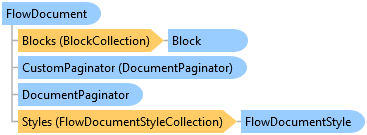

| Intersoft.Client.Documents Namespace : FlowDocument Class |

<ContentPropertyAttribute("Blocks")> Public Class FlowDocument Inherits System.Windows.DependencyObject Implements IDocumentPaginatorSource
Dim instance As FlowDocument
[ContentPropertyAttribute("Blocks")] public class FlowDocument : System.Windows.DependencyObject, IDocumentPaginatorSource
[ContentPropertyAttribute("Blocks")] public ref class FlowDocument : public System.Windows.DependencyObject, IDocumentPaginatorSource
A flow document is designed to "reflow content" depending on window size, device resolution, and other environment variables. It also has a number of built in features including search, viewing modes that optimize readability, and the ability to apply formatting to the flow elements. Flow document is best utilized when ease of reading is the primary document consumption scenario. In contrast, fixed document is useful when fidelity of the source content is essential. For more information about fixed document, see Document Framework Overview.
To view a flow document, it must be contained in a flow document viewer control. There are three types of flow document viewer, which are UXFlowDocumentViewer, UXFlowDocumentPageViewer, and UXFlowDocumentScrollViewer. For further information about these viewers, see the overview of each control.
The following code example shows how to author a simple FlowDocument in a UXFlowDocumentViewer.
| XAML |
Copy Code
|
|---|---|
<Intersoft:UXFlowDocumentViewer> <Intersoft:FlowDocument> <Intersoft:Paragraph> <Intersoft:Run> Hello World </Intersoft:Run> </Intersoft:Paragraph> </Intersoft:FlowDocument> </Intersoft:UXFlowDocumentViewer> |
|

System.Object
System.Windows.DependencyObject
Intersoft.Client.Documents.FlowDocument
Target Platforms: Windows 7, Windows Vista SP1 or later, Windows XP SP3, Windows Server 2008 (Server Core not supported), Windows Server 2008 R2 (Server Core supported with SP1 or later), Windows Server 2003 SP2